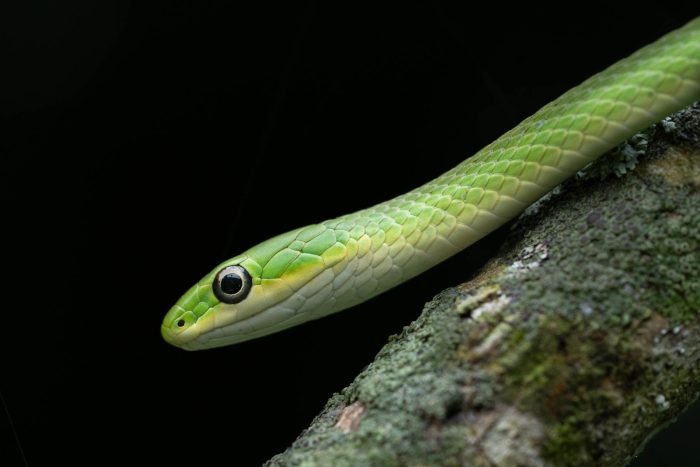Rough Green Snake
Opheodrys aestivus aestivus
The rough green snake is a non-venomous snake with a long, slender, bright green body. It lives in leafy trees and shrubs in thickly vegetated areas throughout the Chesapeake Bay region.
This section shows one large critter image at a time. Use the thumbnails that follow to select a specific image to display here.

This gallery contains a grid of small thumbnails. Selecting a thumbnail will change the main image in the preceding section.
Appearance
The rough green snake grows to 22 to 32 inches in length. It has a long, slender, bright green body covered with rough-looking scales and a white, cream or yellow belly.
Feeding
Rough green snakes feed primarily on insects such as crickets, caterpillars and grasshoppers, though they will also eat snails, spiders and small frogs. They use their excellent vision to find and track down prey.
When rough green snakes are within striking range of their prey, they assume spring-like curves with their body. They then straighten out their entire body at once, allowing the snake to propel its head toward the prey.
Predators
Birds, larger snakes, domestic cats and even some large spiders prey upon rough green snakes. They do not bite and are relatively defenseless. However, they are well camouflaged in dense vegetation, where they hide from predators.
Reproduction and life cycle
Male rough green snakes court females using a variety of motor patterns, including chin rubbing, tail waving and head jerking. They usually leave the female immediately after breeding occurs. Females reach sexual maturity at 21 to 33 months. They lay two to 12 eggs in June or July, typically in a moist location such as in a tree hollow or under a rock.
Several females will often share a nest. Eggs hatch in August and September, yielding baby snakes that are seven to eight inches long. These snakes have been known to live up to eight years in captivity.
Did you know?
- This snake gets its name from the rough-looking scales that cover its green body.
- Rough green snakes prefer to live in lush, thickly vegetated areas, including moist woods, streamside forests and backyard gardens.
- Unlike most species of snakes, these snakes are diurnal, meaning they are most active during the day. They hibernate during the cold winter months.
- It is the only tree-dwelling snake in the Bay region.
- Rough green snakes are docile and do not bite.
- Although rough green snakes usually live in trees, they are also very good swimmers.
Sources and additional information
- Animal Diversity Web: Opheodrys aestivus – University of Michigan Museum of Zoology
- Northern Rough Green Snake – Florida Museum of Natural History
